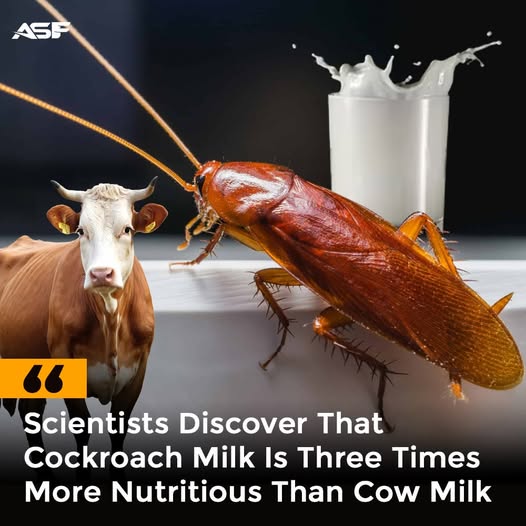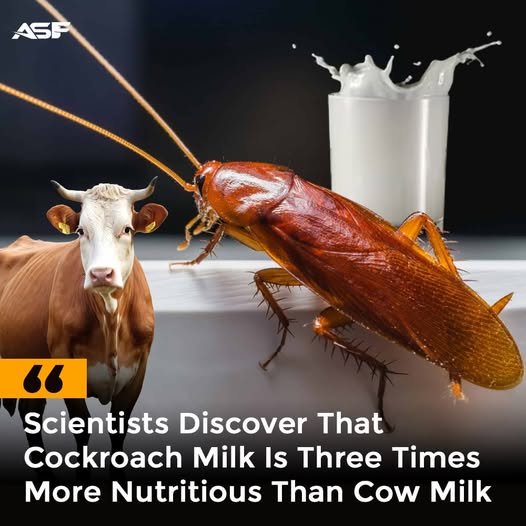Cockroaches are often considered pests, feared for their resilience and ability to thrive in various environments, but recent scientific breakthroughs have shown that one species, Diploptera punctata, the only known cockroach that produces milk, may hold the key to a future superfood with unparalleled nutritional potential. Studies have revealed that cockroach milk is not only more nutritious than cow milk but is also packed with proteins, fats, and sugars that make it an intriguing candidate for human consumption. With ongoing research into the sustainability and production of cockroach milk, this discovery opens up a realm of possibilities for future food sources, especially in the context of the growing need for alternative, sustainable nutrition options.

Understanding the Discovery: A Nutritional Powerhouse
In 2008, scientists made the unexpected discovery that cockroaches from the species Diploptera punctata produce a substance that closely resembles milk. Unlike typical milk-producing animals, which produce milk to nourish their young, Diploptera punctata secretes a protein-rich liquid to feed its embryos inside the mother’s brood sac. This milk is not only unique in terms of its composition but also in terms of its high nutritional value. The discovery piqued the curiosity of researchers, as they found that this cockroach milk contains proteins, fats, and sugars in a specific ratio that is three times more nutritious than cow milk. This ratio of macronutrients makes it a rich source of energy and essential nutrients, which could have vast implications for human health.
The primary nutritional benefit of cockroach milk is its high protein content, which is crucial for growth, repair, and maintenance of the human body. Proteins are made up of amino acids, the building blocks necessary for muscle development and immune function. In addition to proteins, cockroach milk is rich in fats—essential fatty acids that are required for brain function, energy production, and the absorption of fat-soluble vitamins. The sugars in cockroach milk, predominantly in the form of glucose, provide a rapid source of energy, making it an ideal candidate for high-performance food products. All of these components work synergistically to create a highly nutritious substance that could rival or even surpass many current superfoods.
Sustainability: A Game-Changer for the Future of Food
As the global population continues to grow and the environmental strain on food production systems intensifies, scientists are increasingly exploring alternative food sources that are both nutritionally dense and environmentally sustainable. Traditional animal agriculture, while providing substantial nutrition, is also associated with significant environmental challenges, including land use, water consumption, and greenhouse gas emissions. This is where cockroach milk offers a potential solution.
Cockroaches are highly efficient creatures, capable of thriving in low-resource environments and reproducing at a rapid pace. Their ability to produce nutrient-dense milk in a relatively small space, coupled with their low environmental footprint, positions them as an environmentally sustainable alternative to conventional dairy farming. In fact, cockroaches require far less water, land, and food compared to livestock like cows or goats, making them a more resource-efficient option for large-scale production. Additionally, cockroach farming could have a much lower carbon footprint, reducing the environmental impact associated with traditional agriculture.
Researchers are currently investigating ways to optimize the production of cockroach milk in a controlled, sustainable manner. One potential approach is to harness biotechnology and genetic engineering to produce the milk’s beneficial components in a lab setting, eliminating the need for large-scale cockroach farming. This method could significantly reduce ethical concerns about using live animals while still reaping the nutritional benefits of cockroach milk.
The Future of Cockroach Milk in Human Consumption
While the potential of cockroach milk is undoubtedly exciting, there are still several hurdles to overcome before it can be widely produced and consumed by humans. For one, the process of extracting and processing the milk is complex and labor-intensive, as the amount of milk produced by each cockroach is minuscule. Scientists are working on improving the extraction process and exploring alternative methods, such as bioengineering microbes to produce cockroach milk proteins, which could make the process more scalable and efficient.
Another challenge is public perception. The idea of consuming cockroach-derived products might be met with skepticism and resistance, especially in cultures where the very thought of eating insects is taboo. However, as the global food industry continues to innovate, there may be a shift in consumer attitudes, particularly as the benefits of alternative proteins and sustainable food sources become more apparent. It’s worth noting that insects, in general, are already consumed in many parts of the world and have been recognized for their high nutritional value. With time, education, and increased awareness about the environmental and health benefits of cockroach milk, it is possible that it could gain acceptance as a legitimate and nutritious food source.
To bridge this gap, researchers and food scientists are focusing on developing processed products that incorporate cockroach milk in more familiar forms. For example, it could be included in energy bars, smoothies, or protein powders, making it easier for consumers to integrate it into their daily diet. By starting with such products, the public may gradually become more accustomed to the idea of cockroach milk without the immediate shock factor of consuming it in its raw form.
Health Benefits and Potential Applications
The health benefits of cockroach milk are significant, not only because of its high nutrient content but also because of its potential to address specific health needs. For example, the protein in cockroach milk may be especially beneficial for athletes and individuals involved in intense physical activities, as it can aid in muscle recovery and provide sustained energy. Moreover, the milk’s high concentration of essential amino acids and fatty acids could support individuals with dietary deficiencies or those looking to improve their overall health.
Beyond its potential for human nutrition, cockroach milk could have applications in the medical field as well. Its rich protein content could be useful in the development of specialized nutrition for patients with severe malnutrition or chronic illnesses, as the milk provides easily digestible and bioavailable nutrients. Additionally, researchers are investigating whether the bioactive compounds found in cockroach milk could have therapeutic properties, such as anti-inflammatory or antimicrobial effects, further expanding its potential uses.
Conclusion: A New Frontier in Food Innovation
Cockroach milk, once considered an unlikely candidate for human consumption, has now emerged as a revolutionary discovery with the potential to reshape the way we think about food, nutrition, and sustainability. Its high nutritional content, combined with the environmental benefits of cockroach farming, makes it a promising option for the future of food production. While challenges remain in terms of production scalability, consumer acceptance, and regulatory approval, the continued research into cockroach milk’s benefits and sustainable production methods is paving the way for a new frontier in food innovation.
As the world faces increasing challenges related to food security and environmental sustainability, alternative food sources like cockroach milk could provide a vital solution. By embracing such innovations and exploring new, sustainable ways to produce and consume food, we can ensure a more resilient and nutritious food system for future generations. The future of food may very well involve a surprising and unexpected ingredient—cockroach milk.


